Grumman F8F Bearcat
| F8F Bearcat | |
|---|---|
.jpg) |
|
| Role | Fighter aircraft |
| Manufacturer | Grumman |
| First flight | 21 August 1944 |
| Introduction | 1945 |
| Retired | 1955 (United States Navy) 1960 (Royal Thai Air Force) |
| Status | Retired |
| Primary users | United States Navy United States Marine Corps French Air Force Royal Thai Air Force |
| Number built | 1,266 |
The Grumman F8F Bearcat (affectionately called "Bear") was an American single-engine naval fighter aircraft of the 1940s. It went on to serve into the mid-20th century in the United States Navy and other air forces, and would be the company's final piston engined fighter aircraft.
Contents |
Design and development
Work on the Grumman G-58 Bearcat began in 1943 with the intention to provide the U.S. Navy with a high performance derivative of the F6F. This aircraft should be able to operate from the smallest carrier, primarily in the interceptor role. The F6F's Pratt & Whitney R-2800 engine was kept but compared to the Hellcat, the Bearcat was 20% lighter, had a 30% better rate of climb and was 50 mph (80 km/h) faster. To achieve this, the range was necessarily sacrificed.[1]
In comparison with the Vought F4U Corsair, the initial Bearcat (F8F-1) was marginally slower but was more maneuverable and climbed more quickly. Its huge 12 ft 4 in Aero Products four-bladed propeller required a long landing gear (made even longer by the mid-fuselage position of the wing), giving the Bearcat an easily-recognized, "nose-up" profile. The hydraulically operated undercarriage used an articulated trunnion which extended the length of the oleo legs to lengthen when down; as the undercarriage retracted the legs were shortened, enabling them to fit into a wheel well which was entirely in the wing. An additional benefit of the inward retracting units was a wide track, which helped counter propeller torque on takeoff and gave the F8F good ground and carrier deck handling.[2]. For the first time in a production Navy fighter, a bubble canopy offered 360° visibility.
The Bearcat concept was inspired by the early 1943 evaluation of a captured Focke-Wulf Fw 190 by Grumman test pilots and engineering staff.[3] After flying the Fw 190, Grumman test pilot Bob Hall wrote a report directed to President Leroy Grumman, who then personally laid out the specifications for Design 58, the successor to the Hellcat. Design 58 closely emulated the design philosophy of the German fighter, although no part of the Fw 190 was copied. The F8F Bearcat stemmed from Design 58 [2] with the primary missions of outperforming highly maneuverable late-model Japanese fighter aircraft such as the A6M5 Zero.[4] A role which later developed was that defending the fleet against incoming airborne suicide (kamikaze) attacks.[5]
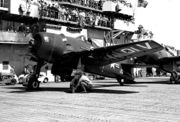
The target loaded weight of 8,750 lb/3,969 kg (derived from the land-based German aircraft) was essentially impossible to achieve as the structure of the new fighter had to be made strong enough for aircraft carrier landings. Structurally the fuselage used flush riveting as well as spot welding, with a heavy gauge 302W aluminum alloy skin.[2] Armor protection was provided for the pilot, engine and oil cooler; weight saving measures include restricting the internal fuel capacity to 160 gal (606 l) [2](later 183)[6] and limiting the fixed armament to four .50 cal Browning M2/AN machine guns, two in each wing.
As a weight-saving concept the designers came up with detachable wingtips; if the g-force exceeded 7.5 g then the tips would be allowed to snap off, leaving a perfectly flyable aircraft still capable of carrier landing. While this worked very well under carefully controlled conditions in flight and on the ground, in the field, where aircraft were repetitively stressed by landing on carriers and since the wings were slightly less carefully made in the factories, there was a possibility that only one wingtip would break away with the possibility of the aircraft crashing.[7] This was replaced with an explosives system to blow the wings off together, which also worked well, however this ended when a ground technician died due to accidental triggering. In the end the wings were reinforced and the aircraft limited to 7.5 g.[8]
Grumman's project pilot for the Bearcat series was legendary test pilot Corky Meyer, who also had this role on the Grumman F6F Hellcat, F7F Tigercat, F9F Panther, XF10F-1 Jaguar, and the F11F Tiger series. Meyer was head of Grumman Flight Operations at Edwards Air Force Base from 1952–56.[9][10]
Another famous name is associated with the type; when asked his favorite aircraft to fly, Neil Armstrong's immediate and unequivocal answer was "Bearcat". Armstrong had flown the type in 1950 during his Navy Advanced Training, field qualifying in it at age 19.[11]
Operational history
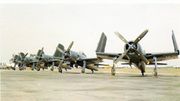
The F8F prototypes were ordered in November 1943 and first flew on 21 August 1944, a mere nine months later. The first production aircraft was delivered in February 1945 and the first squadron was operational by 21 May, but World War II was over before the aircraft saw combat service.
Postwar, the F8F became a major U.S. Navy fighter, equipping 24 fighter squadrons. Often mentioned as one of the best-handling piston-engine fighters ever built, its performance was sufficient to outperform many early jets. Its capability for aerobatic performance is illustrated by its selection for the Navy's elite Blue Angels in 1946, who flew it until the team was temporarily disbanded in 1950 (during the Korean War). The F9F Panther and McDonnell F2H Banshee largely replaced the Bearcat in USN service, as their performance and other advantages eclipsed piston-engine fighters.
An unmodified production F8F-1 set a 1946 time-to-climb record (after a run of 115 ft/35 m) of 10,000 ft (3,048 m) in 94 seconds (6,383 fpm). The Bearcat held this record for 10 years until it was broken by a modern jet fighter (which could still not match the Bearcat's short takeoff distance).
Other nations that flew the Bearcat included the French Air Force and Royal Thai Air Force. French aircraft saw combat service against the Viet Minh in the First Indochina War as fighter-bombers in the early 1950s.[12] They were used to support French Forces at the Battle of Dien Bien Phu, operating at the edge of their combat radius, but failed to prevent the French defeat that brought about the end of the war.[13] Nearly 70 surviving aircraft passed to the Vietnam Air Force upon its creation in 1955.[14]
Air racing
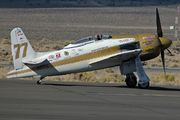
Bearcats have long been popular in air racing. A stock Bearcat flown by Mira Slovak and sponsored by Bill Stead won the first Reno Air Race in 1964. Rare Bear, a highly-modified F8F owned by Lyle Shelton, went on to dominate the event for decades, often competing with Daryl Greenamyer, another famous racer with victories in his own Bearcat ("Conquest I") and holder of a propeller-driven aircraft world speed record in it. Rare Bear also set many performance records, including the 3 km World Speed Record for piston-driven aircraft (528.33 mph/850.26 km/h), set in 1989), and a new time-to-climb record (3,000 m in 91.9 seconds, set in 1972, breaking the 1946 record cited above).[15][16][17]
Variants
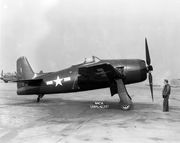

- G-58
- Company designtion.
- G-58A
- Two civil aircraft. The first was owned by the Gulf Oil Company for the use of Major Alford Williams, the second one was used by Grumman as a demonstrator aircraft.
- XF8F-1
- Prototype aircraft, two built.
- F8F-1 Bearcat
- Single-seat fighter aircraft, equipped with folding wings, a retractable tailwheel, self-sealing fuel tanks, a very small dorsal fin, powered by a 2,100 hp (1,566 kW) Pratt & Whitney R-2800-34W Double Wasp radial piston engine, armed with four 0.50 in (12.7 mm) machine guns.
- F8M-1 Bearcat
- F8F-1 Bearcats built by General Motors.
- F8F-1B Bearcat
- Single-seat fighter version, armed with four 20 mm cannons.
- F8F-1(D) Bearcat
- Export version for France and Thailand.
- XF8-1N
- Night fighter prototypes, two built.
- F8F-1N Bearcat
- Night fighter version, equipped with an APS-19 radar.
- XF8F-2
- F8F-2 prototypes, two built.
- F8F-2 Bearcat
- Improved version, equipped with a redesigned engine cowling, taller fin and rudder, armed with four 20 mm (.79 in) cannons, powered by a Pratt & Whitney R-2800-30W radial piston engine, 293 built.
- F8F-2N Bearcat
- Night-fighter version, equipped with an APS-19 radar.
- F8F-2P Bearcat
- Photo-reconnaissance version, fitted with camera equipment, armed with two 20 mm (.79 in) cannons.
- F8F-1D and F8F-2D
- Small numbers of F8F-1s and F8F-2s were converted into drone control aircraft.
- F3M-1
- Planned designation for F8F aircraft constructed by General Motors.
Operators
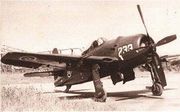
- Air Force of El Salvador (FAS)
- Captured from FAH
 Honduras
Honduras
- Honduran Air Force (FAH)[18]
- One purchased from South Vietnam
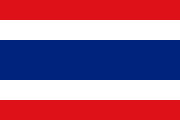 Thailand
Thailand
- Royal Thai Air Force
- Vietnam Air Force
Surviving aircraft

A small number of Bearcats survive: approximately 11 are airworthy (several as racing aircraft), eight are restored for static display and approximately a dozen more are wrecks or restoration projects.
Darryl Greenamyer's Bearcat, "Conquest I" can be seen on exhibit at the Smithsonian National Air & Space Museum.
Specifications F8F-1 and F8F-2
Data from Jane's Fighting Aircraft of World War II[19], [4]
General characteristics
- Crew: 1 pilot
- Length: 28 ft 3 in (8.61 m)
- Wingspan: 35 ft 10 in (10.92 m)
- Height: 13 ft 9 in (4.21 m)
- Wing area: 244 ft²[20] (22.67 m²)
- Empty weight: 7,070 lb (3,207 kg)
- Loaded weight: 9,600 lb (4,354 kg)
- Max takeoff weight: 12,947 lb (5,873 kg)
- Powerplant: 1× Pratt & Whitney R-2800-34W "Double Wasp" two-row radial engine, 2,100 hp (1,567 kW)
Performance
- Maximum speed: 421 mph (366 kn, 678 km/h)
- Range: 1,105 mi (1,778 km)
- Service ceiling: 38,700 ft (11,796 m)
- Rate of climb: 4,570 ft/min (23.2 m/s)
- Wing loading: 66.7 lb/ft² (192.1 kg/m²)
- Power/mass: 0.22 hp/lb (360 W/kg)
Armament
- Guns: 4 × 0.50 in (12.7 mm) machine guns (Four 20mm M3 cannon F8F-1B)
- Rockets: 4× 5 in (127 mm) unguided rockets
- Bombs: 1,000 lb (454 kg) bombs
Data from F8F Bearcat in action[21]
General characteristics
- Length: 28 ft 3 in (8.61 m)
- Wingspan: 35 ft 10 in (10.92 m)
- Height: 13 ft 10 in (4.21 m)
- Empty weight: 7,650 lb (3,207 kg)
- Loaded weight: 10,200 lb (4,627 kg)
- Max takeoff weight: 13,460 lb (6,105 kg)
- Powerplant: 1× Pratt & Whitney R-2800-30W two-row radial engine, 2,250 hp (1,678 kW)
Performance
- Maximum speed: 455 mph (405 kn, 730 km/h)
- Range: 1,105 mi (1,778 km)
- Service ceiling: 40,800 ft (12,436 m)
- Rate of climb: 6,300 ft/min (32.0 m/s)
- Power/mass: 0.22 hp/lb (360 W/kg)
Armament
- Guns: 4 × 20 mm (.79 in) M3 cannon
- Rockets: 4× 5 in (127 mm) unguided rockets
- Bombs: 1,000 lb (454 kg) bombs
See also
Related development
Comparable aircraft
- Hawker Sea Fury
- Vought F4U Corsair
Related lists
- List of fighter aircraft
- List of military aircraft of the United States
- List of United States naval aircraft
References
- Notes
- ↑ Swanborough and Bowers 1991, p. 241.
- ↑ 2.0 2.1 2.2 2.3 Scrivner 1990, p. 4.
- ↑ Meyer 1998, p. 42.
- ↑ 4.0 4.1 Maloney 1969
- ↑ "F8F Bearcat." U.S. Naval Air Museum. Retrieved: 18 August 2010.
- ↑ Scrivner 1990, p. 7.
- ↑ Scrivner 1990, p. 14.
- ↑ Meyer, Corwin W. "Clipping the Bearcat's wing." Retrieved: 18 August 2010.
- ↑ "Grumman test pilots." www.GrummanPark.org. Retrieved: 18 August 2010.
- ↑ Meyer, Corwin. Corky Meyer's Flight Journal: A Test Pilot's Tales Of Dodging Disasters-Just In Time. North Branch, Minnesota: Specialty Press, 2006. ISBN 1-58007-093-0.
- ↑ Hanson, James R. First Man: The Life of Neil A. Armstrong. New York: Simon & Schuster, 2005. ISBN 0-74325-751-0.
- ↑ "The war in Indo-China goes on." The News Magazine of the Screen, December 1953. Retrieved: 18 August 2010.
- ↑ Manevy 1993, pp. 278–280.
- ↑ "AVIA Camouflage Profiles: Grumman F8F Bearcat." Wings Palette. Retrieved: 18 August 2010.
- ↑ www.RareBear.com—Lyle Shelton's "Rare Bear" [Note that Shelton's claim to be the "fastest propeller-driven aircraft in the world" does not acknowledge faster turboprop aircraft such as the Russian Tupolev Tu-95 Bear bomber. Other sources credit "Rare Bear" as the fastest "piston-driven" aircraft.]
- ↑ "Aircraft speed records." www.AeroSpaceWeb.org. Retrieved: 18 August 2010.
- ↑ "Speed records from archives of the Society of Air Racing Historians." www.AirRace.com. Retrieved: 18 August 2010.
- ↑ "The Bearcat of the 100 Hour War." internetmodeler.com. Retrieved: 18 August 2010.
- ↑ Bridgman 1946, p. 233.
- ↑ Scrivner 1990, p. 31.
- Bibliography
- Andrews, Hal. The Grumman F8F Bearcat (Aircraft in profile 107). Windsor, Berkshire, UK: Profile Publications Ltd., 1972 (reprinted from 1966).
- Bridgman, Leonard. "The Grumman Bearcat." Jane’s Fighting Aircraft of World War II. London: Studio, 1946. ISBN 1-85170-493-0.
- Chant, Christopher. Grumman F8F Bearcat: Super Profile. Sparkford, Yeovil, UK: Haynes Publishing, 1985. ISBN 0-85429-447-3.
- Drendel, Lou. U.S. Navy Carrier Fighters of World War II. Carrollton, TX: Squadron/Signal Publications Inc., 1987. ISBN 0-89747-194-6.
- Green, William. "Grumman F8F-1 Bearcat". War Planes of the Second World War, Volume Four: Fighters. London: Macdonald & Co. (Publishers) Ltd., 1961, pp. 109–111. ISBN 0-356-01448-7.
- Green, William and Gordon Swanborough. "Grumman F8F Bearcat". WW2 Fact Files: US Navy and Marine Corps Fighters. London: Macdonald and Jane's Publishers Ltd., 1976, pp. 62–63. ISBN 0-356-08222-9.
- Maloney, Edward T. Grumman F8F Bearcat (Aero Series Vol. 20). Fallbrook, California: Aero Publishers, 1969. ISBN 0-8168-0576-8.
- Manevy, Jean Christophe. "French Bearcats in Indo-China 1951-1954". Air International, June 1993, Vol. 44, No. 6, pp. 278–280. Stamford, UK: Key Publishing. ISSN 0306-5634.
- Meyer, "Corky". "Clipping the Bearcat's Wing." Flight Journal, Vol. 3, no. 4, August 1998.
- Morgan, Eric B. "Grumman's Hot Rod." Twenty-first Profile, Volume 1, no. 12. New Milton, Hantfordshire, UK: Profile Publications, 1972. ISSN 0961-8120.
- Morgan, Eric B. "Grumman Bearcat part II." Twenty-first Profile, Volume 2, no. 17. New Milton, Hantfordshire, UK: Profile Publications, 1972. ISSN 0961-8120.
- O'Leary, Michael. United States Naval Fighters of World War II in Action. Poole, Dorset, UK: Blandford Press, 1980. ISBN 0-7137-0956-1.
- Scrivner, Charles L. F8F Bearcat in Action, Aircraft number 99. Carrollton, Texas: Squadron/Signal Publications Inc., 1990. ISBN 0-89747-243-8.
- Swanborough, Gordon and Peter M. Bowers. United States Navy Aircraft since 1911. Annapolis: Naval Institute Press 1991, pp. 241–243. ISBN 0-87021-792-5.
- Taylor, John W.R. "Grumman F8F Bearcat". Combat Aircraft of the World from 1909 to the Present. New York: G.P. Putnam's Sons, 1969. ISBN 0-425-03633-2.
External links
- Aircraft.co.za - The Complete Aviation Reference
- Warbird Alley: Bearcat page - Information about Bearcats still flying today
|
|||||||||||||||||||||||||||||||
|
|||||||||||||||
|
||||||||||||||||||||||||||||||||||||||||||||||||||||||||||||||
|
||||||||||||||